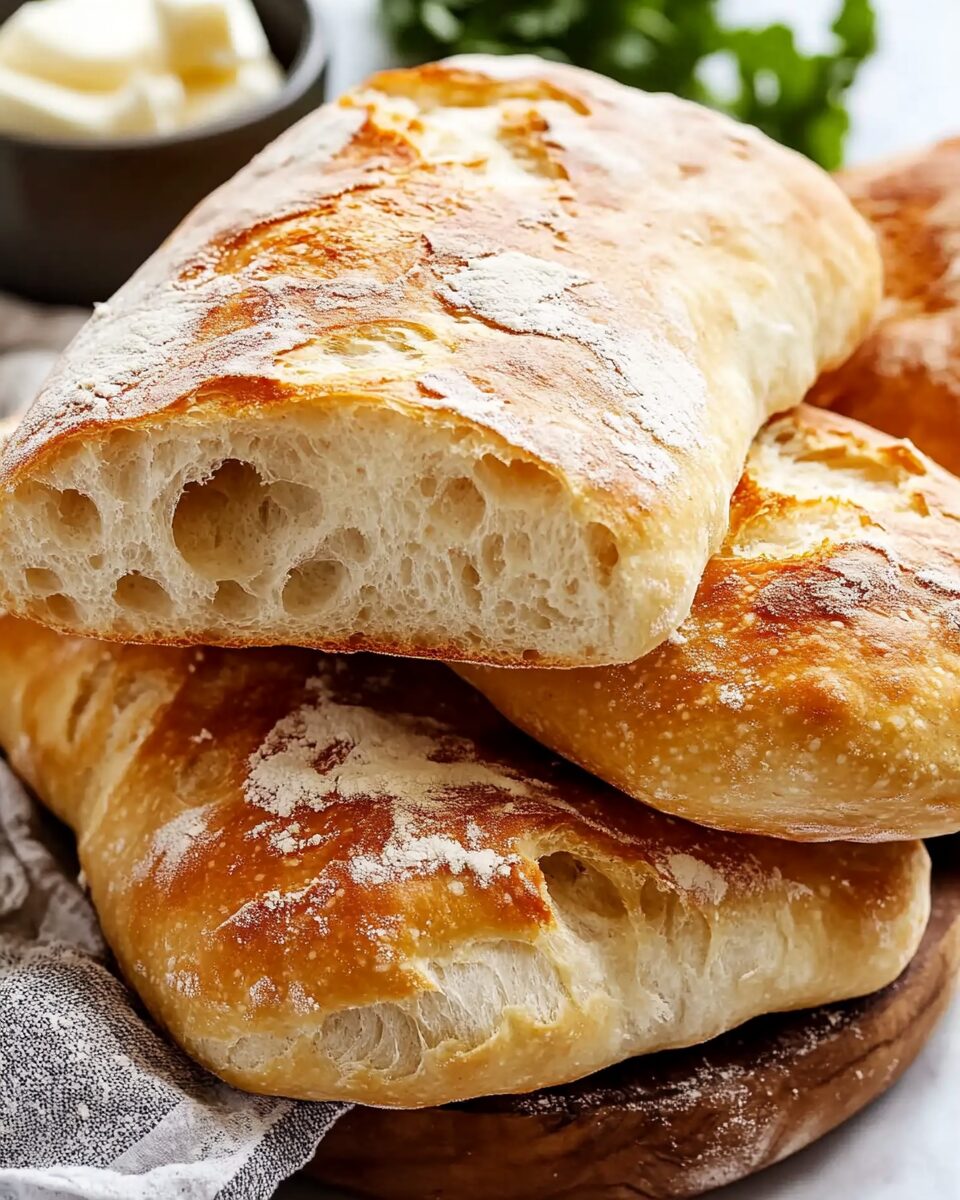This Ciabatta Bread recipe delivers an irresistibly crispy crust with a soft, airy interior—true to its rustic Italian roots. Whether you’re new to bread baking or a seasoned home baker, this straightforward, no-fuss recipe will guide you to golden loaves that are perfect for sandwiches, dipping, or enjoying warm with butter. With just a few pantry staples and a little patience, you can bring the authentic aroma and flavor of homemade artisan bread into your kitchen.
Full Recipe:
Ingredients
-
4 cups all-purpose flour
-
1½ cups warm water (about 110°F)
-
2¼ tsp active dry yeast (1 packet)
-
2 tsp salt
-
2 tbsp olive oil (plus more for drizzling)
Optional:
-
Coarse sea salt for topping
-
Fresh herbs (e.g., rosemary or thyme)
-
Chopped olives or sun-dried tomatoes for mix-ins
Directions
1. Make the Dough:
In a large bowl, mix flour and yeast. Gradually add warm water, stirring until a shaggy dough forms.
2. Knead:
Turn the dough out onto a floured surface. Knead for about 10 minutes until smooth and elastic.
3. First Rise:
Transfer dough to a lightly oiled bowl. Cover with a damp cloth and let rise in a warm place for about 2 hours, until doubled in size.
4. Shape the Loaves:
Gently punch down the dough. Divide it into two equal pieces. Shape each into a rustic rectangular loaf.
5. Second Rise:
Place loaves on parchment-lined baking sheets. Cover with a cloth and let rise again for about 1 hour.
6. Bake:
Preheat oven to 450°F (230°C). Drizzle each loaf with olive oil and sprinkle with sea salt. Bake for 25–30 minutes, until golden brown and the loaves sound hollow when tapped.
7. Cool and Serve:
Transfer to a wire rack to cool slightly. Serve warm or at room temperature.
Nutrients (Per Slice, ~50g)
-
Calories: 130
-
Carbohydrates: 25 g
-
Protein: 4 g
-
Fat: 2 g
-
Saturated Fat: 0 g
-
Fiber: 1 g
-
Sodium: 200 mg
-
Cholesterol: 0 mg
The History and Character of Ciabatta
Ciabatta, which means “slipper” in Italian, was first created in the 1980s as a response to the popularity of French baguettes. Italian bakers wanted something similarly light and crusty, but with its own personality. The result was ciabatta: a uniquely flat, open-crumbed loaf that quickly became a staple throughout Italy and eventually around the globe. Its high hydration dough produces the signature large air pockets, while its rustic form gives it that charming, hand-formed look.
Unlike sandwich loaves that are precisely shaped and tightly crumbed, ciabatta is intentionally loose, free-form, and airy. Its mild flavor makes it a perfect canvas for everything from gourmet sandwiches to savory toast topped with tomatoes, basil, and a drizzle of olive oil.
What Makes Ciabatta Unique
The defining feature of ciabatta bread is its open crumb structure, which results from a wetter dough than most traditional breads. This dough can be sticky and somewhat tricky to handle at first, but that’s what gives it its distinctive lightness. There’s no need for shaping perfection—the beauty of ciabatta lies in its irregularity. You can expect rustic, beautifully imperfect loaves with airy holes and a chewy, golden crust.
Another distinguishing factor is the use of olive oil, which enriches the dough and contributes a subtle richness to the flavor while also helping to develop that beloved crispy crust during baking.
The Simplicity of Artisan Bread at Home
One of the biggest appeals of this recipe is its simplicity. With only four base ingredients—flour, water, yeast, and salt—it transforms pantry staples into a loaf that rivals anything from a bakery. You don’t need a stand mixer, baking stone, or sourdough starter. All you need is a bit of time and a willingness to get your hands slightly sticky.
Despite its minimalism, the results are impressive. The bread comes out of the oven golden and blistered, with a hollow thud when tapped and a texture that yields to a knife yet resists just enough to give that classic chew.
Why Patience Pays Off
While the process for ciabatta is simple, it does require time for fermentation. This long, slow rise is what develops both the flavor and texture of the dough. Allowing the yeast to work at its own pace produces not only those gorgeous air pockets but also a more complex, slightly tangy flavor.
The first rise gives the dough its bulk, while the second rise—after shaping—allows the gluten to relax and the air to redistribute. These are not steps to rush. Letting the dough double in size naturally ensures a beautifully light crumb and a more flavorful loaf.
Tips for Success
Although the recipe is straightforward, here are a few tips to ensure success:
Handle the dough gently. Because of its high hydration, ciabatta dough is delicate. Avoid pressing or deflating it too aggressively between rises.
Flour your surface generously. The dough will be sticky. Use plenty of flour when kneading and shaping to keep it manageable without overworking it.
Let it rise fully. The dough should roughly double in size during both rises. If your kitchen is cool, consider placing the dough in a slightly warmed oven (turned off) to encourage fermentation.
Use steam in the oven. For an extra-crispy crust, place a pan of hot water on the bottom rack while baking, or mist the oven walls with water during the first few minutes.
Cool before slicing. Although tempting, let the loaf cool for at least 20 minutes to allow the crumb to set fully. Cutting into hot bread can compress the crumb and make it gummy.
Ways to Use Ciabatta Bread
The beauty of ciabatta is its versatility. It’s sturdy enough to hold sauces and spreads, light enough to enjoy on its own, and flavorful enough to elevate simple ingredients. Try it with:
Sandwiches: Its soft interior and crusty shell make it ideal for pressed paninis or deli-style sandwiches.
Toasts: Brush with olive oil, grill lightly, and top with fresh tomatoes, garlic, and basil for a classic bruschetta.
Soup Dipper: Serve warm slices alongside tomato soup or minestrone to soak up every last drop.
Breakfast Base: Toasted ciabatta makes an excellent platform for poached eggs, avocado, or melted cheese.
Appetizers: Slice thinly, toast, and serve with charcuterie, hummus, or dips.
You can even cube leftovers and toast them into croutons for salads or tear them into hearty chunks for panzanella.
Health and Nutritional Balance
Ciabatta bread, while indulgent in taste and texture, can also be part of a balanced diet. Each slice offers a moderate dose of carbohydrates for energy, a small amount of fat from olive oil, and a modest amount of protein. With no added sugars and zero cholesterol, it’s a wholesome option compared to many store-bought loaves.
For added nutrients, you can incorporate whole wheat flour for a fiber boost or mix in seeds and herbs for texture and added flavor. Optional toppings like sea salt or chopped rosemary can enhance taste without overwhelming the bread’s natural profile.
Storage and Freshness
Like all artisan breads, ciabatta is best enjoyed fresh the day it’s baked. However, it stores well for up to two days at room temperature when wrapped in a clean kitchen towel or paper bag. To refresh, simply reheat in a 350°F oven for 5–7 minutes.
If you’d like to keep it longer, ciabatta freezes beautifully. Wrap it tightly in foil and place in a freezer bag. Thaw overnight and reheat to restore its crisp crust and tender crumb.
Conclusion
This rustic Ciabatta Bread recipe is the perfect gateway into artisan bread baking at home. It offers the ideal balance of a crisp crust, airy interior, and rich, comforting flavor—all with just a handful of ingredients. Whether you’re a seasoned baker or new to bread making, this recipe provides an approachable way to create bakery-quality loaves in your own kitchen. From sandwiches to soups to simple slathered butter, ciabatta brings a touch of rustic elegance to every meal. With a little time and a lot of love, you’ll be rewarded with the unmatched aroma and satisfaction of homemade bread that speaks to tradition and taste in every bite.

